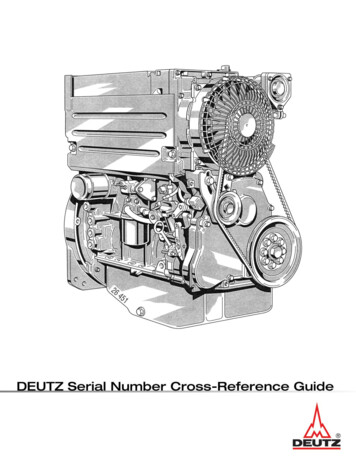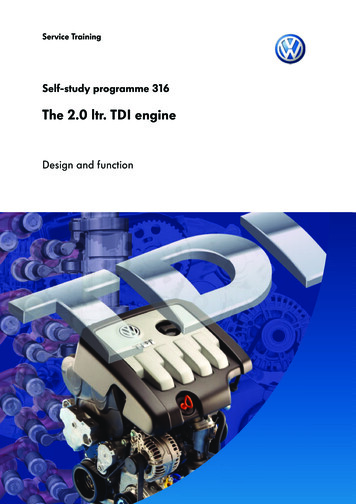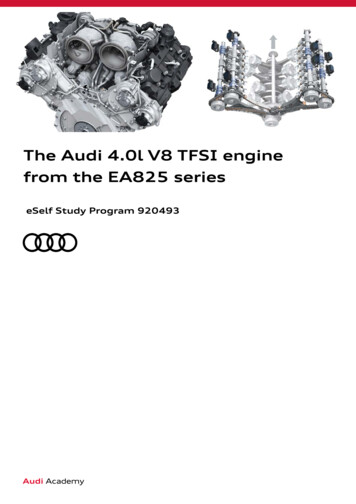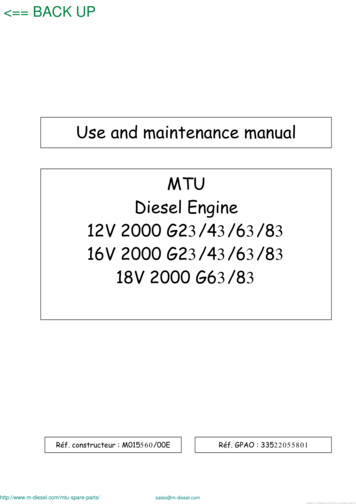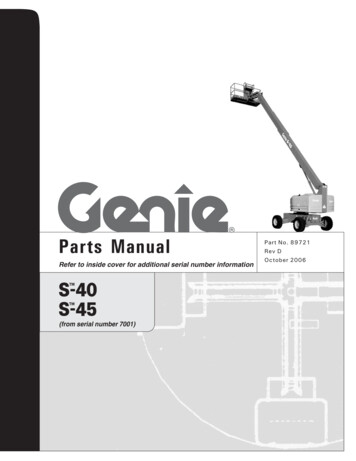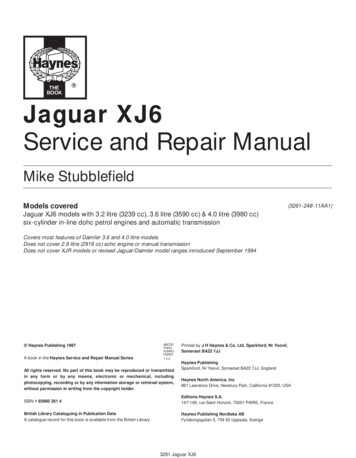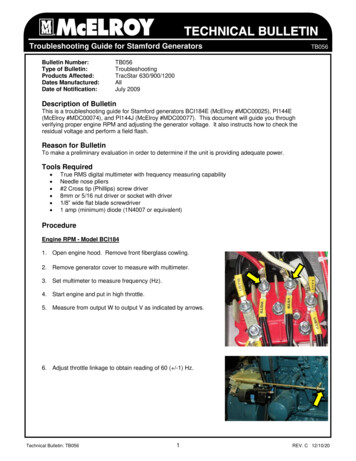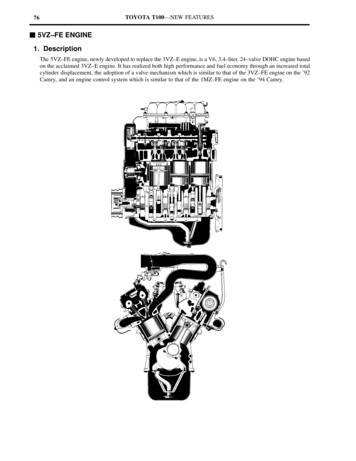
Transcription
TOYOTA T100—NEW FEATURES76 5VZ–FE ENGINE1. DescriptionThe 5VZ–FE engine, newly developed to replace the 3VZ–E engine, is a V6, 3.4–liter, 24–valve DOHC engine basedon the acclaimed 3VZ–E engine. It has realized both high performance and fuel economy through an increased totalcylinder displacement, the adoption of a valve mechanism which is similar to that of the 3VZ–FE engine on the ’92Camry, and an engine control system which is similar to that of the 1MZ–FE engine on the ’94 Camry.
TOYOTA T100—NEW FEATURES772. Engine Specifications and Performance CurveEngine5VZ FE5VZ–FE3VZ E3VZ–ENo. of Cyls. & Arrangement6–Cylinder, V Type Valve Mechanism4–Valve DOHCBelt & Gear Drive2–Valve OHCBelt DrivePentroof TypeSemi–Heron TypeManifoldsCross–Flow Fuel SystemSFI*1ItemCombustion ChamberDisplacementcm3 (cu. in.)Bore x Strokemm (in.)Compression Ratio[EFI]MFI*2 [EFI]3378 (206.1)2959 (180.5)93.5 x 82.0 (3.68 x 3.23)87.5 x 82.0 (3.44 x 3.23)9.6 : 19.0 : 1Max. Output[SAE–NET]142 kW @ 4800 rpm(190 HP @ 4800 rpm)112 kW @ 4800 rpm(150 HP @ 4800 rpm)Max. Torque[SAE–NET]298 N.m @ 3600 rpm(220 ft.lbf @ 3600 rpm)244 N.m @ 3400 rpm(180 ft.lbf @ 3400 rpm)Open4 BTDC11 BTDCClose42 ABDC51 ABDCOpen46 BBDC53 BBDCClose4 ATDC9 ATDC91 API SH, EC–II,ILSAC*3 or BetterAPI SG, SH, EC–II,ILSAC*3 or BetterINValve TimingEXFuel Octane NumberOil GradeRON*1: SFI (Sequential Multiport Fuel Injection)*2: MFI (Multiport Fuel Injection)3* : ILSAC (International Lubricant Standardization and Approval Committee)
TOYOTA T100—NEW FEATURES783. Features of 5VZ–FE EngineThe features of the 5VZ–FE engine and comparison between the 3VZ–E engine in the previous models, 3VZ–FEengine in the ’92 Camry and 1MZ–FE engine in the ’94 Camry listed below.Item A pentroof type combustion chamber plushigh compression ratio.Engine Proper A cast iron crankshaft with 5 balanceweights.Valve Mechanism Direct–drive DOHC with a 4–valvecross–flow layout for high 1005VZ–FE3VZ–E — —— — Details3VZ–FE 1MZ–FELubrication System The water–cooler type engine oil cooler isused to lower the engine oil temperature. ——Cooling System An aluminum radiator core is used for —— ——— ——— — —— *1 *2—— *3 —— A rotary solenoid type IAC*4 [ISC] valve is —— A diagnosis system conforming to OBD–II. —— weight reduction. The shape of the intake air chamber andIntake andExhaust Systemintake manifold is modified to improve theintake efficiency. A semi–dual crossover pipe is used toimprove the exhaust efficiency. An air–assisted fuel system is used toFuel Systempromote atomizing of the fuel for improvedfuel economy. Cold start injector and pulsation damperhave been discontinued.Ignition System TheDIS (Direct Ignition System)contributes to the powerful high output byproviding a powerful spark to the engine. The hot–wire type mass flow meterEngine ControlSystemimproves the accuracy of the intake airvolume measurement.used in the IAC*4 [ISC] system.*1: Only the cold start injector has been discontinued.*2: 2–Cylinder simultaneous ignition system*3: Independent ignition system*4: IAC (Idle Air Control)
TOYOTA T100—NEW FEATURES794. Engine ProperCylinder HeadAlong with the increase in the cylinder displacement from the 3VZ–E to the 5VZ–FE engine, the diameter of theintake and exhaust ports has been increased.PistonThe semi–floating type piston pin is replaced by the full–floating type to match the higher power output from theincreased piston displacement.5. Valve MechanismGeneralThe construction and operation of the valve mechanisms of the 5VZ–FE engine are basically the same as those ofthe 3VZ–FE engine in the ’92 Camry, except for the changes listed below.CamshaftsThe camshaft drive gear and sub–gear are thinner and the snap ring for the drive gear has been discontinued for weightreduction.Timing Pulleys and Belt The timing belt tooth configuration has beendesigned to help reduce noise and to enable thebelt to transmit power under high load factors. The timing rotor for the crankshaft positionsensor has been integrated into the crankshaftpulley. The timing rotor for the camshaft positionsensor has been integrated into the right bankcamshaft timing pulley.
TOYOTA T100—NEW FEATURES806. Lubrication SystemGeneralThe lubrication system of the 5VZ–FE engine is basically the same as that in the 3VZ–FE engine of the ’92 Camry.However, in order to lower the engine oil temperature on all models (except the 2WD model with automatictransmission), a water cooled oil cooler has been adopted.*: Except 2WD model with Automatic Transmission
TOYOTA T100—NEW FEATURES817. Cooling SystemGeneralThe cooling system of the 5VZ–FE engine is basically the same as that in the 3VZ–E engine of the previous model.However, the shape of the cooling fan and the fan coupling characteristics of the temperature controlledauto–coupling fan have been modified.*1: Only for 2WD models with a load capacity of 0.5 t.*2: Except 2WD models with Automatic Transmission.
TOYOTA T100—NEW FEATURES82Cooling Fan and Coupling FanThe shape of the cooling fan and the fan coupling characteristic of the temperature coupling fan have been modifiedto decrease the cooling fan noise and increase fuel efficiency. Fan Coupling Characteristics 8. Intake and Exhaust SystemAir Cleaner and Intake Air Connector A large–capacity air cleaner is used to increasethe intake air efficiency and reduce the intake airnoise. A resonator is equipped with an air connectorhose to reduce the intake air noise.Throttle BodyA rotary solenoid type IAC* [ISC] valve isintegrated with the throttle body. As this valve canaccurately control the fast idle and idle speed, theidle speed adjusting screw is eliminated from thethrottle body.A dash pot is used on the manual transmissionmodels only.*: IAC (Idle Air Control)
TOYOTA T100—NEW FEATURES83Intake Air Chamber and Intake Manifold The length and diameter of the intake manifoldand intake air chamber ports have beenoptimized. Each port has been lengthened andequalized for enhanced intake efficiency. The intake manifold gasket and intake airchamber gasket have rubber coating appliedonto both surfaces, and provide superiordurability.Exhaust ManifoldA semi–dual crossover pipe is used to improve the exhaust gas efficiency.Exhaust Pipe The exhaust pipe routing has been changed from the left side of the vehicle to the right side. Accordingly, the fueltank has been moved from the right side of the vehicle to the left side, similar to the RCK10 model. In accordance with the increased cylinder displacement, the muffler capacity has been increased (16 L 22 L),and the exhaust pressure reduced.
TOYOTA T100—NEW FEATURES849. Fuel SystemAir Assist Fuel Injection SystemThis system is designed to regulate air intake to the upperstream (atmospheric side) of the throttle valve using theIAC* [ISC] valve, and direct it to the nozzle of the fuel injector inside the intake manifold (negative pressure side).This promotes atomization of the fuel while reducing emissions and improving fuel economy and idle stability.A rotary solenoid type IAC* [ISC] valve is used. Its basic construction and operation are the same as those in the1MZ–FE engine on the ’94 Camry.10.Ignition SystemGeneralA DIS [Direct Ignition System] has been adopted in the 5VZ–FE engine. The DIS improves the ignition timingaccuracy, reduces high–voltage loss, and enhances the overall reliability of the ignition system by eliminating thedistributor.Unlike an independent ignition system which has one ignition coil for each cylinder as in the DIS of the 1MZ–FEengine on the ’94 Camry, the DIS in the 5VZ–FE engine is a 2–cylinder simultaneous ignition system which ignites2–cylinders simultaneously with one ignition coil.
TOYOTA T100—NEW FEATURES85IgniterThe internal system diagram of the igniter is shown below. A characteristic of this igniter is that it contains the 3 powertransistors as illustrated. Based on the IGT signals input for each cylinder the drive circuit activates the respectivepower transistors to control the primary ignition current (IGC) for all ignition coils. At the same time, the igniter alsosends an ignition confirmation signal (IGF) as a fail–safe function to the ECM* [engine ECU].For further details regarding igniter control by the ECM* [engine ECU], see page 94.*: ECM (Engine Control Module)Ignition Coil1) ConstructionThe DIS system of the 5VZ–FE engine consists of 3 sets of ignition coils integrated with plug caps, and with thehigh–tension cords attached directly onto the ignition coil.These ignition coils have a magnet instead of an iron core. Since the magnetic flux is thus strengthened, thenumber of coiled wires within the coil can be reduced, making the coil compact and lightweight.
TOYOTA T100—NEW FEATURES862) OperationIn the DIS system of 5VZ–FE engine, each spark plug is connected to the end of the secondary winding. Highvoltage generated in the secondary winding is applied directly to 2 spark plugs. In one of the spark plugs, thespark passes from the center electrode to the ground electrode and in the other plug the discharge is in the oppositedirection, i.e., from the ground electrode to the center electrode.Spark PlugsTwin ground electrode type spark plugs are used on the 5VZ–FE engine. Due to the employment of the DIS system,the number of spark produced is double that produced in the conventional ignition system. To maintain spark plugdurability, the ground electrodes have been made bipolar.Recommended Spark g Gap1.0 1.1 mm(0.0394 0.0433 in.)11.Engine MountingThe engine mounting of the 5VZ–FE engine is basically the same as in the 3VZ–E engine for the previous models.
TOYOTA T100—NEW FEATURES8712.Engine Control SystemGeneralThe engine control system of the 5VZ–FE engine is basically the same as in the 1MZ–FE engine of the ’94 Camry.The engine control system of the 5VZ–FE engine, 3VZ–E engine in the previous models and 1MZ–FE engine in the’94 Camry compare as E1MZ–FEAn L–type SFI [EFI] system directly detects theintake air volume with a hot–wire type mass airflow meter. — An L–type MFI (Multiport Fuel Injection) [EFI]system directly detects the intake air volume with avane type volume air flow meter.— —The fuel injection system is a sequential multiportfuel injection system. However, during startingonly, it becomes a 3–group type which injects fuelinto 2 cylinders at a time. — — —SystemSFI(SequentialMultiportpFuelI j i )Injection)[EFI]OutlineThe fuel injection system is an all cylinders Page 93 simultaneous injection type.Cold StartInjectorWhen the coolant temperature is low, the injectionduration of the cold start injector is controlled bythe ECM*1 [engine ECU] and start injector timeswitch.— —ESA(Electronic SparkAdvance)Ignition timing is determined by the ECM*1[engine ECU] based on signals from varioussensors. Corrects ignition timing in response toengine knocking. In vehicles equipped with automatic transmission,torque control correction during gear shifting hasbeen used to minimize shift shock. — 2 knock sensors are used to further improve knock Page 94 detection. —(1 Sensor) IAC (Idle Air Control)[ISC]A rotary solenoid type IAC [ISC] valve controls thefast idle and idle speeds. — ACIS(Acoustic ControlInduction System)The intake air passages are switched according tothe engine speed and throttle valve angle toincrease performance in all speed ranges.—— Fuel Pump ControlFuel pump operation is controlled by signals fromthe ECM*1 [engine ECU] based on the enginespeed signal (Ne). — *1: ECM (Engine Control Module)
TOYOTA T100—NEW MZ–FEOutlineFuel PressureControlIn hot engine conditions, the fuel pressure isincreased to improve restartability. Oxygen SensorHeater ControlMaintains the temperature of the oxygen sensor atan appropriate level to increase accuracy ofdetection of the oxygen concentration in the exhaustgas. Air ConditioningControlBy turning the air conditioning compressor ON orOFF in accordance with the engine condition,drivability is maintained. EGR Cut–OffControlCuts off EGR according to the engine condition tomaintain drivability of the vehicle and durability ofthe EGR components. *2 PAIR(Pulsed SecondaryAir Injection)[AS] ControlThe ECM*1 [engine ECU] controls PAIR [AS] bymeans of PAIR control in accordance with engineconditions to reduce exhaust emissions and preventoverheating of the three–way catalyst converters.— —EvaporativeEmission ControlThe ECM*1 [engine ECU] controls the purge flowof evaporative emissions (HC) in the charcoalcanister in accordance with engine conditions. —DiagnosisWhen the ECM*1 [engine ECU] detects amalfunction, the ECM*1 [engine ECU] diagnosesand memorizes the failed section. The diagnosis system complies with OBD–II.The diagnosis items (the failed sections) arediscriminated by connecting the Toyota hand–held Page 95 tester to the newly designed data link connector 3. — When the ECM*1 [engine ECU] detects amalfunction, the ECM*1 [engine ECU] stops orcontrols the engine according to the data already Page 95 stored in memory. Fail–Safe*1: ECM (Engine Control Module)*2: 2WD model with a load capacity of 0.5 t only.
TOYOTA T100—NEW FEATURES89ConstructionThe configuration of the engine control system can be broadly divided into three groups: the ECM [engine ECU],the sensors and the actuators, as shown in the following chart.Shaded portionsare different from the 1MZ–FE engine for the ’94 Camry.
90TOYOTA T100—NEW FEATURESEngine Control System Diagram*1: MIL (Malfunction Indicator Lamp) [Check Engine Lamp]*2: DLC1 & 3 (Data Link Connector 1) [Check Connector], (Data Link Connector 3) [for OBD–II]*3: 2WD model with a load capacity of 0.5 t only*4: Automatic transmission model only*5: 4WD model only
TOYOTA T100—NEW FEATURESLayout of Components91
TOYOTA T100—NEW FEATURES92Main Components of Engine Control SystemThe following table compares the main components of the 5VZ–FE engine and 3VZ–E engine in the previous models,and the 1MZ–FE engine in the ’94 Camry.Model’95 T100’94 T100’94 Camry5VZ FE5VZ–FE3VZ E3VZ–E1MZ FE1MZ–FEHot–Wire Type—Hot–Wire TypeVolume Air Flow Meter—Vane Type—Throttle Position SensorLinear Type Crankshaft Position SensorPick–Up Coil Type, 1Pick–Up Coil Type, 1(built into distributor)Pick–Up Coil Type, 1Camshaft Position SensorPick–Up Coil Type, 1Pick–Up Coil Type, 2(built into distributor)Pick–Up Coil Type, 1Knock SensorBuilt–In PiezoelectricElement Type, 2Built–In PiezoelectricElement Type, 1Built–In PiezoelectricElement Type, 2Oxygen SensorHeated Oxygen Sensor(Bank 1, Sensor 1)(Bank 1, Sensor 2)Engine TypeComponentsMass Air Flow MeterInjectorIAC [ISC] ValveMain HeatedOxygen SensorSub HeaterOxygen Sensor*Heated Oxygen Sensor(Bank 1, Sensor 1)(Bank 2, Sensor 1)(Bank 1, Sensor 2)2–Hole Type withAir Assist1–Hole Type2–Hole Type withAir AssistRotary Solenoid TypeN.A.Rotary Solenoid Type*: California spec. vehicles only1) Mass Air Flow MeterThe hot–wire type mass air flow meter is designed for direct electrical measurement of the intake air mass flow.It has the following features: Compact and lightweight Ability to measure a wide intake air mass flow Superior response and measuring accuracy Having no mechanical functions, it offers superior durability.For details of the principle and operation of the hot–wire type mass air flow meter, see the ’93 1/2 Toyota SupraNew Car Features (Pub. No. NCF096U), page 106.
TOYOTA T100—NEW FEATURES932) Camshaft and Crankshaft Position Sensorsa. Camshaft Position SensorThe camshaft position sensor, which detectsthe crankshaft angle signal [G signal], has beeninstalled on the right bank cylinder head. Thetiming rotor has been integrated with the rightbank camshaft timing pulley. For the basicoperation of the camshaft position sensor, see’94 model New Car Features (Pub. No.NCF099U), page 58.b. Crankshaft Position SensorThe crankshaft position sensor, which detects the engine speed and crankshaft angle signal [NE signal], has beeninstalled on the oil pump body. For basic operation of the crankshaft position sensor, see ’94 model New CarFeatures (Pub. No. 099U), page 58.SFI (Sequential Multiport Fuel Injection) [EFI]The SFI [EFI] system of the 5VZ–FE engine is basically the same as that of the 1MZ–FE engine for ’94 Camry.
TOYOTA T100—NEW FEATURES94ESA (Electronic Spark Advance)The ESA system of the 5VZ–FE engine is basically the same in construction and operation as that of the 1MZ–FEengine ’94 Camry. However, in the 5VZ–FE engine, the output method of the ignition trigger signal (IGT) from theECM* [engine ECU] to the igniter has been changed to reflect the adoption of the DIS (Direct Ignition System).1) Igniter ControlAfter determining the ignition timing based on the signals from the camshaft position sensor (G) and thecrankshaft position sensor (NE), the ECM* [engine ECU] outputs individual IGT signals (IGT1 to IGT3) to theigniter.In response to the IGT signals, the igniter returns IGF signals to the ECM* [engine ECU]. In the DIS, the ON(HI) and OFF (LO) signals of the IGF waveform are opposite of those from other models.*: ECM (Engine Control Module)
TOYOTA T100—NEW FEATURES95DiagnosisThe diagnosis system of the 5VZ–FE engine complies with OBD–II. For OBD–II requirements, see ’94 Toyota ModelNew Car Features (Pub. No. NCF099U), page 2. For details of the following items, refer to the ’95 Toyota T100 RepairManual (Pub. No. RM414U).ItemContentsData Link ConnectorData Link Connector 3 added for OBD–II.Diagnostic Trouble Code Check MethodPerform by connecting the Toyota hand–held tester to Data LinkConnector 3.Diagnostic Trouble CodeECM* [Engine ECU] Memory Items—Freezed frame data added.*: ECM (Engine Control Module)Fail–SafeThe fail–safe functions of the 5VZ–FE engine are as follows:Fail–Safe FunctionCircuit with Abnormal SignalsMass Air Flow Meter Signal (VG)Fixed values (standard values) based on the condition of the STAsignal and IDL contacts are used for the fuel injection duration andthe ignition timing (10 BTDC), making engine operation possible.Engine Coolant Temp. Sensor[Water Temp. Sensor] Signal (THW)Fixed value (standard value) is used: 80 C (176 F) for engine coolanttemp.Intake Air Temp. Signal (THA)Fixed value (standard value) is used: 20 C (68 F) for intake air temp.Throttle Position Sensor Signal (VTA)A fixed value of 0 throttle valve opening angle is used. Knock Sensor Signal (KNK) Knock Control SystemThe corrective retard angle value is set to the maximum value.Ignition Confirmation Signal (IGF)Fuel injection is stopped.13.Emission Control SystemSystem PurposeSystemAbbreviationPurposePositive crankcase ventilationPCVReduces blow–by gas (HC)Evaporative emission controlEVAPReduces evaporative HCExhaust gas recirculationEGR*Reduces NOxThree–way catalytic converterTWCReduces HC, CO and NOxSequential Multiport Fuel Injection[Electronic fuel injection]SFI [MFI]Regulates all engine conditions forreduction of exhaust emission*: 2WD model with a load capacity of 0.5 t onlyComponents Layout and Schematic DrawingFor details of the components layout and schematic drawing, refer to the ’95 Toyota T100 Repair Manual(Pub. No. RM414U).
5VZ-FE ENGINE 1. Description The 5VZ-FE engine, newly developed to replace the 3VZ-E engine, is a V6, 3.4-liter, 24-valve DOHC engine based . A dash pot is used on the manual transmission models only. *: IAC (Idle Air Control) TOYOTA T100—NEW FEATURES 83 Intake Air Chamber and Intake Manifold
